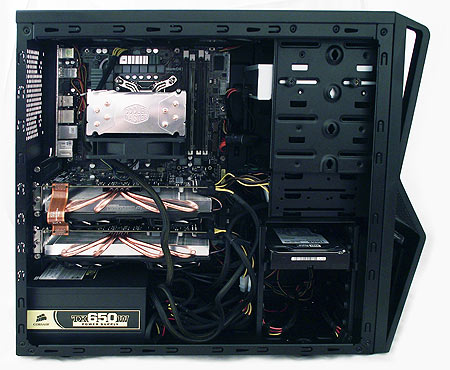System Builder Marathon, December 2010: $1000 PC
Although we were afraid of the results, this time around we decided to try something new, forgoing the Core i5 in favor of a dual-core Core i3 CPU in our build. Can the higher clock rate compensate for the loss of two physical cores in our $1000 system?
Assembly And Overclocking
The only trouble we experienced during installation was a boot hang caused by an older BIOS that didn’t play nice with the Core i3-550 processor. Temporarily switching to Intel's Pentium G6950 just long enough to install a fresh BIOS saved the day.
We have to say that our $1000 SBM machines have always looked sleek, but this time the combination of parts comes together for a very sexy final result. By chance, everything ended up being black, including the case, motherboard, graphics cards, power supply, and even the memory modules. The accent colors are aluminum and copper from the CPU and graphics card heat sinks, making for a very attractive build. We couldn’t have made it prettier if we tried.
Overclocking
A final overclock of 4.0 GHz isn’t bad by any stretch of the imagination. Unfortunately, we didn't get any miracles with this combination, and despite our ambitions, a stable 4 GHz was the best we could do. With the CPU set to 1.35 V, IMC at 1.3 V, PLL at 1.9 V, and PCH at 1.15 V; the highest BCLK frequency we could muster was 167.5 MHz. Multiply that by the CPU's 24x ratio and you have our final overclock of 4019 MHz.
There isn’t a suitable memory multiplier at this bus speed that will let us keep our latencies low, so the final memory clock is 502 MHz (1004 MT/s) at 7-7-7-24-1T timings.
When it comes to graphics, the ECS GeForce GTX 460 cards in SLI don’t disappoint, overclocking to 825/1650 MHz core/shaders and 950 MHz memory. This should take the performance of the graphics system close to what a couple of GeForce GTX 470 cards in SLI would muster.
Get Tom's Hardware's best news and in-depth reviews, straight to your inbox.
Current page: Assembly And Overclocking
Prev Page Memory, Hard Drive, And Optical Drive Next Page Test Systems And BenchmarksDon Woligroski was a former senior hardware editor for Tom's Hardware. He has covered a wide range of PC hardware topics, including CPUs, GPUs, system building, and emerging technologies.
-
AMW1011 I can't say I'm impressed this time. You should never have went with a clarksdale, they are simply bad. Getting a more reasonably priced motherboard, cutting another $20 from the HDD and PSU, and an i5 750, would have been much better.Reply
Still, we have more information than before so I can't complain. -
Poisoner That PSU only has 2 PCI-E hook ups. So you'll have to use adapters in this build. Pathetic.Reply -
ivan_chess The CPU choice was a little disappointing this time around. A Core i5 or even a comparably priced AMD processor would have done much better (especially in productivity because four cores are typically better than two).Reply -
adbat I think it would be good to include previous build in the test system page it would make comparison easier.Reply -
duk3 1 tb 7200.12 hard drive?Reply
GTX 570? (debatable)
Cheaper motherboard, maybe not supporting SLI if gtx 570 is taken over 460 sli?
$50 corsair ddr3 1600?
i5 760 with these savings? -
Core2uu I think we're missing the point of including the Core i3 in this month's build. The purpose was to explore the CPU bottle-necking that can be observed on today's common applications because threading implementation has managed to find itself actually put into effect. Throwing in an i5 760 would have been too predictable and too boring. This puts perspective on the fact that dual-cores matched with high clock speeds are no longer the performance kings as was true more than a year ago.Reply -
amirp like they said in the previous article even the 6000 series radeons weren't out when they made these articles,Reply
reading comprehensions noobs

